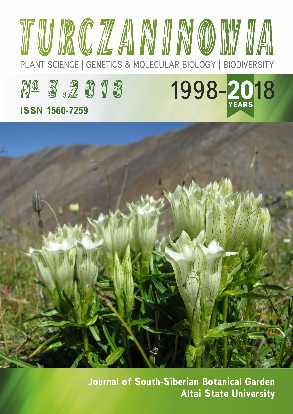Spore morphology of Parahemionitis arifolia (Cheilanthoideae, Pteridaceae)
Abstract
A study of spores of the single species of the genus Parahemionitis Panigrahi was performed using the method of scanning electronic microscopy (SEM). Spores of Parahemionitis arifolia (Burm. f.) Panigrahi are tetrahedral trilete, roundish-triangular in polar position, with micro-wrinkled exospore and sculptured perispore. Sculpture of perispore is cristate-reticulate, cristae are quite regularly distributed and form reticulum with small mostly closed polygonal luminae of different shape. Laesura arms are often obscured by numerous cristae. Size of spores is 53–63 × 40–42 μm. Spores of P. arifolia are similar in perispore sculpture with those of species of some cheilanthoid ferns.Downloads
Metrics
References
Burmanni N. L. 1768. Flora Indica: cui accedit series zoophytorum Indicorum, nec non prodromus florae Capensis. Apud Cornelium Haek, Amsterdam, 32 pp. DOI: https://doi.org/10.5962/bhl.title.60581
Christenhusz M. J. M., Zhang X.-Ch., Schneider H. 2011. A linear sequence of extant families and genera of lycophytes and ferns. Phytotaxa 19: 7–54. DOI: doi.org/10.11646/phytotaxa.19.1.2.
Fraser-Jenkins C. R. 1997. New species syndrome in Indian pteridology and the ferns of Nepal. International Book Distributors, Dehra Dun, India, 404 pp.
Giannasi D. E. 1974. Phytochemical aspects of fern systematics. Ann. Mo. Bot. Gard. 61: 368–378.
Giannasi D. E., Mickel J. T. 1979. Systematic implications of the flavonoid pigments in the fern genus Hemionitis (Adiantaceae). Brittonia 31: 405–412.
Mazumdar J. 2015. Nomenclatural note on Hemionitis arifolia (Pteridaceae). Fern. Gaz. 20, 2: 91–94.
Mickel J. T. 1974. A redefinition of the genus Hemionitis. Amer. Fern. J. 64, 1: 3–12.
Moore T. 1859. Index Filicum. W. Pamplin, London, 109–156 pp. DOI: doi.org/10.5962/bhl.title.55301
Morton C. V. 1974. William Roxburgh’s fern types. Contributions U. S. Nat. Herb. 38(7): 283–396. URL: http://www.biodiversitylibrary.org/item/13798 (Accessed 15.07.2018).
Nayar B. K., Devi S. 1966. Spore morphology of the Pteridaceae. I. The Pteridoid ferns. Grana Palinologica, 6: 476–479. DOI: 10.1080/00173136609430036.
Nayar B. K., Devi S. 1967. Spore morphology of the Pteridaceae II. The Gymnogrammoid ferns. Grana Palynologica, 7(2–3): 568–600. DOI: 10.1080/00173136709430049.
Panigrahi G. 1991. Pteridophytes flora of Orissa. Abstracts and Souvenir Booklet, National Symposium on Current Trends in Pteridology, 4–6 October 1991, Palayamkottai, Tamilnadu, India: 12–13.
Panigrahi G. 1992. Nomenclatural notes on “Hemionitis” arifolia (N. Burm.) Moore (Pteriaceae [sic]). Proc. 79-th Ind. Sci. Congr., Part 3 (Abstracts): 49.
Panigrahi G. 1993. Parahemionitis, a new genus of Pteridaceae. Amer. Fern J. 83(3): 90–92.
Pteridophyte Phylogeny Group. 2016. A community-derived classification for extant lycophytes and ferns. J. Syst. Evol. 54, 6: 563–603. DOI: doi.org/10/1111/jsp12229
Ranker T. 1989. Spore morphology and generic delimitation of New World Hemionitis, Gymnopteris and Bommeria (Adiantaceae). Amer. J. Bot. 76(2): 297–306.
Schuettpelz E., Schneider H., Huiet L., Windham M. D., Pryer K. M. 2007. A molecular phylogeny of the fern family Pteridaceae: аssessing overall relationships and the affinities of previously unsampled genera. Mol. Phylogenet. Evol. 44(3): 1172–1185. DOI: doi.org/10.1016/j.ympev.2007.04.011
Smith A. R., Kathleen M. P., Schuettpelz E., Korall P., Schneider H., Wolf P. G. 2006. A classification for extant ferns. Taxon 3, 55: 705–731. DOI: doi.org/10.2307/25065646
Tryon A. F., Lugardon B. 1991. The spores of pteridophytes: surface, wall structure, and diversity based on electron microscopy studies. Springer-Verlag, Berlin, 648 pp.
Tryon R. M. 1986. Some new names and combinations in Pteridaceae. Amer. Fern J. 76, 4: 184–186.
Tryon R. M., Tryon A. F., Kramer K. U. 1990. Pteridaceae. In: The families and genera of vascular plants. Vol. 1. Pteridophytes and Gymnosperms. Volume Editors: K. U. Kramer, P. S. Green. Springer-Verlag, Berlin, Heidelberg GmbH, 230–256 pp.
Zhang G.-M., Liu H.-M., Yang W.-L., Zhang X.-Ch. 2009. Systematic position of Hemionitis arifolia based on the analysis of rbcL sequences. Journal of Beijing Forestry University 31(6): 15–18.
Winter W. P., Amoroso V. B. (eds). 2003. Plant resources of South-East Asia. № 15(2). Cryptogams: Ferns and fern allies. Backhuys Publishers, Leiden, The Netherlands, 268 pp.
Copyright (c) 2018 Turczaninowia

This work is licensed under a Creative Commons Attribution-NoDerivatives 4.0 International License.
Turczaninowia is a golden publisher, as we allow self-archiving, but most importantly we are fully transparent about your rights.
Authors may present and discuss their findings ahead of publication: at biological or scientific conferences, on preprint servers, in public databases, and in blogs, wikis, tweets, and other informal communication channels.
Turczaninowia allows authors to deposit manuscripts (currently under review or those for intended submission to Turczaninowia) in non-commercial, pre-print servers such as ArXiv.
Authors who publish with this journal agree to the following terms:
- Authors retain copyright and grant the journal right of first publication with the work simultaneously licensed under a Creative Commons Attribution License that allows others to share the work with an acknowledgement of the work's authorship and initial publication in this journal.
- Authors are able to enter into separate, additional contractual arrangements for the non-exclusive distribution of the journal's published version of the work (e.g., post it to an institutional repository or publish it in a book), with an acknowledgement of its initial publication in this journal.
- Authors are permitted and encouraged to post their work online (e.g., in institutional repositories or on their website) prior to and during the submission process, as it can lead to productive exchanges, as well as earlier and greater citation of published work (See The Effect of Open Access).





